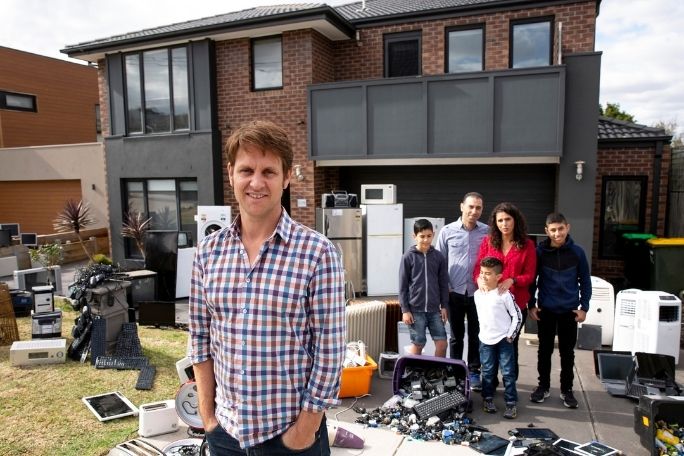Lesson summary
Students explore the topic of e-waste. They begin by thinking about our current household recycling schemes and how e-waste might fit into this system. They then explore some of the problems associated with e-waste, in particular why we are generating so much of it. Students think critically about why we feel we want or need new types of technology before working collaboratively to develop a series of questions to help students think through future electronic purchases.
Learning intentions:
Students will...
- understand what e-waste is and where it comes from
- understand some of the environmental impacts of e-waste
- identify questions we can ask ourselves before buying electronic products
- be introduced to the concepts of planned and perceived obsolescence (Year 6).
Success criteria:
Students can...
- work collaboratively
- generate and test questions
- use scenarios to test ideas
- participate in group and class discussions
- think critically about personal waste production.
Lesson guides and printables
Curriculum links
Select your curriculum from the options below.
Lesson details
Curriculum mapping
Australian curriculum content descriptions:
Year 4 Design and Technologies:
- Recognise the role of people in design and technologies occupations and explore factors, including sustainability that impact on the design of products, services and environments to meet community needs (ACTDEK010)
Years 5 & 6 Design and Technologies:
- Examine how people in design and technologies occupations address competing considerations, including sustainability in the design of products, services, and environments for current and future use (ACTDEK019)
Year 4 HASS:
- Pose questions to investigate people, events, places and issues (ACHASSI073)
- The use and management of natural resources and waste, and the different views on how to do this sustainably (ACHASSK090)
Year 5 HASS:
- Develop appropriate questions to guide an inquiry about people, events, developments, places, systems and challenges (ACHASSI094)
- Work in groups to generate responses to issues and challenges (ACHASSI102)
- The difference between needs and wants and why choices need to be made about how limited resources are used (ACHASSK119)
- Influences on consumer choices and methods that can be used to help make informed personal consumer and financial choices (ACHASSK121)
Year 6 HASS:
- Develop appropriate questions to guide an inquiry about people, events, developments, places, systems and challenges (ACHASSI122)
- Work in groups to generate responses to issues and challenges (ACHASSI130)
- The effect that consumer and financial decisions can have on the individual, the broader community and the environment (ACHASSK150)
Syllabus outcomes: ST2-11LW, ST2-14BE, ST2-15I, ST2-16P, ST3-14BE, ST3-15I, ST3-16P, GE2-2, GE2-3, GE2-4, GE3-4
General capabilities: Critical and Creative Thinking, Literacy
Cross-curriculum priority: Sustainability OI.8.
Relevant parts of Year 4 Design and Technologies achievement standards: Students describe how social, technical and sustainability factors influence the design of solutions to meet present and future needs
Relevant parts of Year 5 & 6 Design and Technologies achievement standards: Students explain how social, ethical, technical and sustainability considerations influence the design of solutions to meet a range of present and future needs
Relevant parts of Year 4 HASS achievement standards: Students identify the interconnections between components of the environment and between people and the environment. Students develop questions to investigate.
Relevant parts of Year 5 HASS achievement standards: Students describe factors that influence their choices as consumers and identify strategies that can be used to inform these choices. They develop questions for an investigation and work with others to generate alternative responses to an issue or challenge.
Relevant parts of Year 6 HASS achievement standards: Students explain why it is important to be informed when making consumer and financial decisions. They develop appropriate questions to frame an investigation and collaboratively generate alternative responses to an issue.
This lesson is part of the wider unit of work: War On Waste – Years 4-6
Time required: 60 mins
Level of teacher scaffolding: Low – lead students in discussions, oversee group activities
Resources required
- Device capable of presenting a website to the class
- E-Waste Scenarios
- Questioning Consumption – Year 4 Questions
- Questioning Consumption – Years 5 & 6 Questions
- Student Worksheets – one copy per student
- Generating Questions Factsheet (optional)
Skills
This lesson is designed to build students’ competencies in the following skills:
- Communication
- Community engagement
- Collaboration
- Critical thinking
- Problem solving
Additional info
Cool Australia’s War On Waste lessons have been developed in partnership with Lune Media and with support from the Australian Environmental Grantmakers Network. These lessons have been designed to lead students through a deeper understanding of some of the big issues relating to waste in Australia and to support them to take action to reduce the impact of waste on our environment.


Welcome back!
Don't have an account yet?
Log in with:
Create your free Cool.org account.
Many of our resources are free, with an option to upgrade to Cool+ for premium content.
Already have an account?
Sign up with:
By signing up you accept Cool.org's Terms and Conditions(Opens in new tab) and Privacy Policy(Opens in new tab).